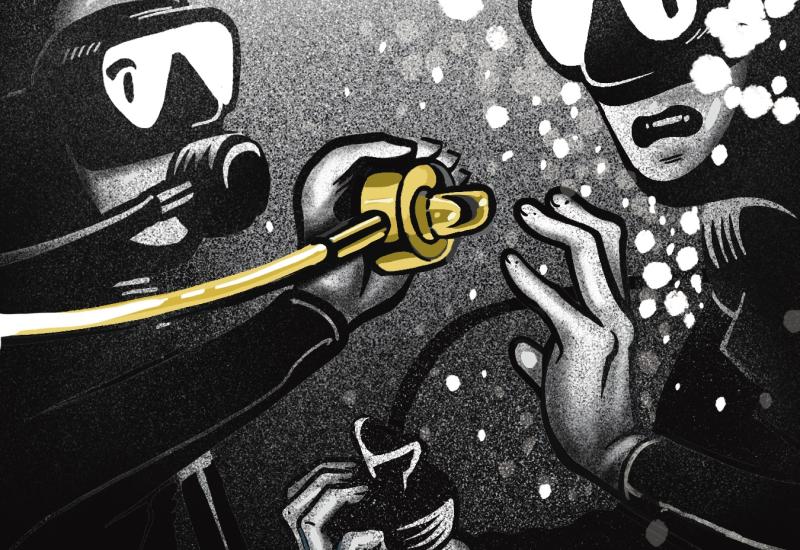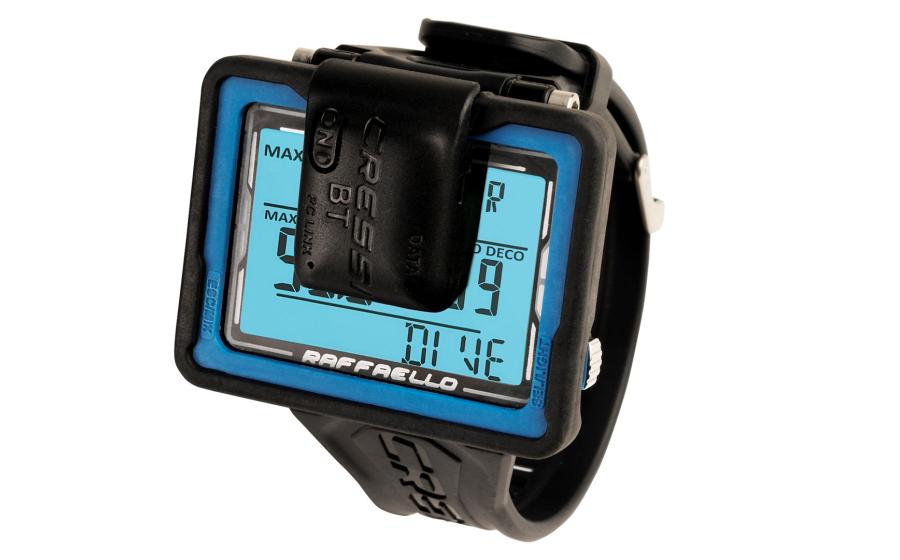Lessons For Life: Worth the Catch?

Lessons For Life Spearfishing
Michael Morgenstern
Offshore oil rigs serve as way stations for big fish, which stop and hang out around the massive structures. Roy and his buddies knew this and made regular trips to nearby oil rigs to go spear fishing. It was the best local opportunity to find game fish, and they always brought home dinner.
On the first dive of the trip, Roy speared a large goliath grouper near the rig. As he began bringing it toward the surface, the 200-pound fish started to swim away, pulling Roy along for the ride.
The Divers
As a dive instructor, Roy trained upwards of 100 new divers each year, but one thing he loved just as much as teaching new divers was spear fishing. In fact, every couple of weeks, Roy and his buddies headed to one of the nearby oil rigs and brought their spear guns along. This way they would always return with dinner.
The Dive
When Roy turned on his air just before getting in the water, his regulator free-flowed for a moment. He slapped it against his hand and reset the diaphragm. With the reg fixed, he did his giant stride and immediately descended down one leg of the oil rig. The visibility was typical for the location — they could see 30 to 40 feet in every direction.
Many of the bigger fish they wanted to hunt stayed deep. When they approached 130 feet, Roy indicated he wanted to go deeper. His buddy signaled that he planned to level off and hunt there. Roy signaled OK and kept descending.
The Accident
Roy couldn’t believe his eyes when he saw the size of the grouper hovering near one of the oil rig’s legs. He estimated it weighed 200 pounds. Roy quickly prepared his gun and shot the fish through the side. He reeled in the cable connecting the spear to his gun and began ascending. Roy could feel the weight of the fish below him, so he focused harder on swimming toward the surface. As he passed 130 feet, Roy paused for a moment to signal to his buddy that he was taking his catch to the boat.
On the way to the surface, the grouper attempted to escape, only to come to a sudden stop when it reached the end of the cable Roy had looped around a D-ring on his BC. The surge pulled Roy to the side as the line snapped taut. He grabbed the cable and attempted to continue ascending, but the grouper took off again — this time, the fish pulled Roy toward the surface. As they ascended together, Roy hit his head on one of the oil rig’s crossbeams. Dazed by the collision, Roy found himself struggling at the surface.
The boat driver reported seeing Roy wave his arm over his head to signal that he needed help. As Roy appeared to lose consciousness, the driver started the boat engines to get to Roy as quickly as possible. Roy sank below the surface before help could arrive. Roy’s buddy and another diver spent nearly 30 minutes searching for, and eventually recovering, his body.
Analysis
When the divers found Roy’s body, his scuba cylinder was empty, his weights were in place, and the grouper was still attached to the cable attached to his BC. Though Roy’s regulator showed signs of poor maintenance, this was not considered to be a cause of the accident.
The medical examiner determined that Roy had suffered trauma to his head after striking the leg of the oil rig, and this was a contributing factor in his loss of control on ascent; this, in turn, led to an air embolism that caused him to lose consciousness and drown.
Roy was in trouble the moment he speared the large grouper. Even if it had been killed instantly, Roy would have struggled to drag his prize to the surface. At the very least, Roy should have asked his buddy to help him get it to the surface. Better still, he could have attached the fish to a lift bag, inflated it and sent it to the surface.
Roy most likely wasn’t thinking clearly when he surfaced. Dazed and likely suffering symptoms from the embolism, if he had dropped his weights and let go of the speared grouper, Roy might have survived the incident.
Roy also was not properly equipped for a dive to nearly 200 feet. A diver depletes a tank very quickly at those depths, yet Roy had no backup or additional air supply. He also hadn’t planned for making decompression stops as he ascended.
Roy made several lapses in judgment, all related to planning. If he had been properly equipped and thought through what he would do if he speared a large fish, he might still be alive today.
Lessons for Life
1 Nothing you find on a dive is worth your life. Struggling to bring an artifact or a speared fish to the surface is a recipe for disaster.
2 If you feel yourself struggling on the surface to stay afloat, release your weights. You’ll be positively buoyant, and able to rest and relax while you are rescued.
3 Plan your dive according to the situation. And make sure you and your buddy are on the same page regarding that plan.
4 Have the proper equipment for the dive you are making.
5 Stay with your buddy.
Eric Douglas co-authored the book Scuba Diving Safety_, and has written a series of dive-adventure-novels and short stories. Check out his website at booksbyeric.com._

Michael Morgenstern
Offshore oil rigs serve as way stations for big fish, which stop and hang out around the massive structures. Roy and his buddies knew this and made regular trips to nearby oil rigs to go spear fishing. It was the best local opportunity to find game fish, and they always brought home dinner.
On the first dive of the trip, Roy speared a large goliath grouper near the rig. As he began bringing it toward the surface, the 200-pound fish started to swim away, pulling Roy along for the ride.
The Divers
As a dive instructor, Roy trained upwards of 100 new divers each year, but one thing he loved just as much as teaching new divers was spear fishing. In fact, every couple of weeks, Roy and his buddies headed to one of the nearby oil rigs and brought their spear guns along. This way they would always return with dinner.
The Dive
When Roy turned on his air just before getting in the water, his regulator free-flowed for a moment. He slapped it against his hand and reset the diaphragm. With the reg fixed, he did his giant stride and immediately descended down one leg of the oil rig. The visibility was typical for the location — they could see 30 to 40 feet in every direction.
Many of the bigger fish they wanted to hunt stayed deep. When they approached 130 feet, Roy indicated he wanted to go deeper. His buddy signaled that he planned to level off and hunt there. Roy signaled OK and kept descending.
The Accident
Roy couldn’t believe his eyes when he saw the size of the grouper hovering near one of the oil rig’s legs. He estimated it weighed 200 pounds. Roy quickly prepared his gun and shot the fish through the side. He reeled in the cable connecting the spear to his gun and began ascending. Roy could feel the weight of the fish below him, so he focused harder on swimming toward the surface. As he passed 130 feet, Roy paused for a moment to signal to his buddy that he was taking his catch to the boat.
On the way to the surface, the grouper attempted to escape, only to come to a sudden stop when it reached the end of the cable Roy had looped around a D-ring on his BC. The surge pulled Roy to the side as the line snapped taut. He grabbed the cable and attempted to continue ascending, but the grouper took off again — this time, the fish pulled Roy toward the surface. As they ascended together, Roy hit his head on one of the oil rig’s crossbeams. Dazed by the collision, Roy found himself struggling at the surface.
The boat driver reported seeing Roy wave his arm over his head to signal that he needed help. As Roy appeared to lose consciousness, the driver started the boat engines to get to Roy as quickly as possible. Roy sank below the surface before help could arrive. Roy’s buddy and another diver spent nearly 30 minutes searching for, and eventually recovering, his body.
Analysis
When the divers found Roy’s body, his scuba cylinder was empty, his weights were in place, and the grouper was still attached to the cable attached to his BC. Though Roy’s regulator showed signs of poor maintenance, this was not considered to be a cause of the accident.
The medical examiner determined that Roy had suffered trauma to his head after striking the leg of the oil rig, and this was a contributing factor in his loss of control on ascent; this, in turn, led to an air embolism that caused him to lose consciousness and drown.
Roy was in trouble the moment he speared the large grouper. Even if it had been killed instantly, Roy would have struggled to drag his prize to the surface. At the very least, Roy should have asked his buddy to help him get it to the surface. Better still, he could have attached the fish to a lift bag, inflated it and sent it to the surface.
Roy most likely wasn’t thinking clearly when he surfaced. Dazed and likely suffering symptoms from the embolism, if he had dropped his weights and let go of the speared grouper, Roy might have survived the incident.
Roy also was not properly equipped for a dive to nearly 200 feet. A diver depletes a tank very quickly at those depths, yet Roy had no backup or additional air supply. He also hadn’t planned for making decompression stops as he ascended.
Roy made several lapses in judgment, all related to planning. If he had been properly equipped and thought through what he would do if he speared a large fish, he might still be alive today.
Lessons for Life
1 Nothing you find on a dive is worth your life. Struggling to bring an artifact or a speared fish to the surface is a recipe for disaster.
2 If you feel yourself struggling on the surface to stay afloat, release your weights. You’ll be positively buoyant, and able to rest and relax while you are rescued.
3 Plan your dive according to the situation. And make sure you and your buddy are on the same page regarding that plan.
4 Have the proper equipment for the dive you are making.
5 Stay with your buddy.
Eric Douglas co-authored the book Scuba Diving Safety_, and has written a series of dive-adventure-novels and short stories. Check out his website at booksbyeric.com._










